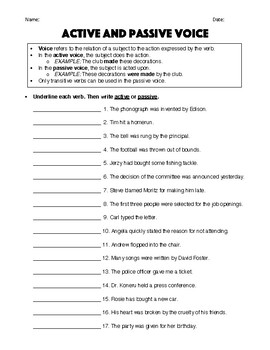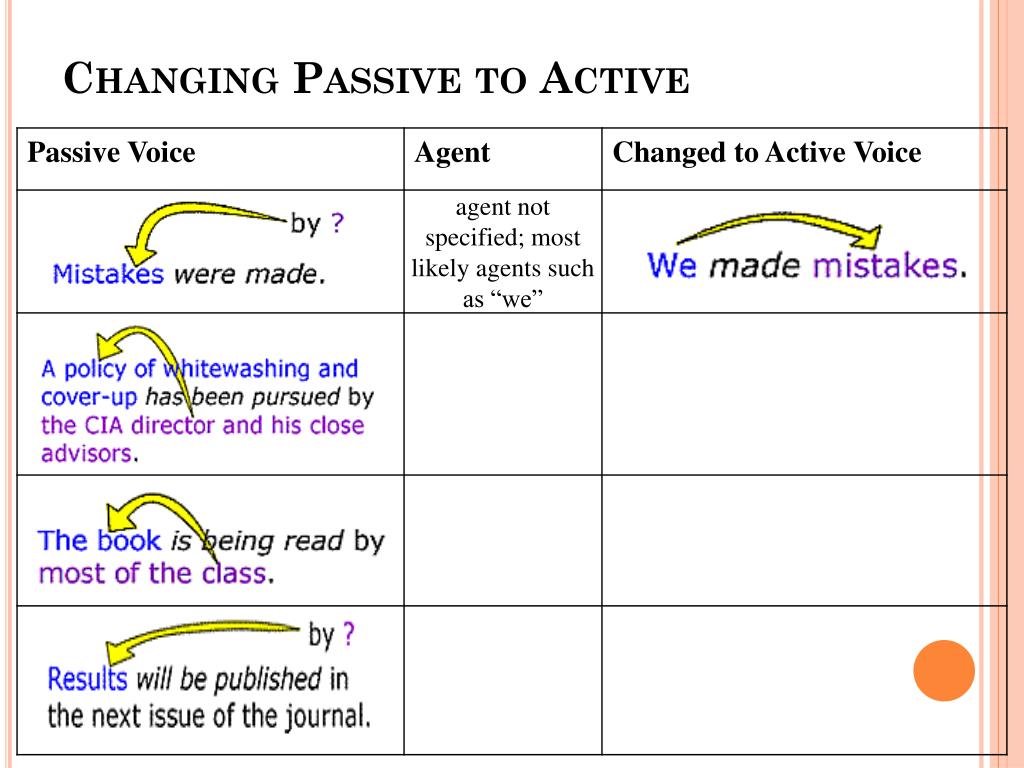

Passive to active voice in 3 simple steps
Active vs passive voice script how to#
To avoid that, let’s take a look at how to fix passive voice sentences in instances where the active voice will serve you better. However, if you’re writing something meant to invite readers in - like a novel - then relying too heavily on passive voice can result in writing that feels a little flat. There are times when it’s the right choice. Just to avoid the direct humiliation of Mrs Smith.Īs you can see, passive voice isn’t something you need to avoid at all costs. Mrs Smith sent Mr Warren another invitation to dine with them, though he had declined the first four. Though he had graciously declined the first four, on Monday morning Mr Warren discovered he had been sent another invitation to dine with the Smiths. For example, if we were to put our best Jane Austen bonnet on, we might write something like this: Jane Austen, for example, loved to coyly poke fun at her characters by using a passive structure for an outward display of polite, ladylike manners. Likewise, a journalist might use phrases such as, “It has been decided that…” or “A mistake was made…” to avoid defaming someone or making a statement that could be untrue.Įven novelists can make use of the passive voice in this way. When a topic is ambiguous, academics find the passive phrase “It is suggested that…” much more appealing than “I think that…”. It allows you to more easily avoid personal pronouns and to present information in a way that sounds unbiased. If you are writing something that requires objectivity - like a research paper - passive voice can also be your friend.

The same goes for scientific writing, where a solution that is being dissolved in water, for example, is a lot more significant than the lab technician doing the dissolving. You could write: “The woman was sentenced by the judge to five years in jail” - but everybody knows who does the sentencing in the courtroom, so that information is unnecessary clutter. “The judge sentenced the woman to five years in jail.” “The woman was sentenced to five years in jail.”īut here, the emphasis is on the judge’s ruling: You can leave the driving force of the action out, and place emphasis on the receiver of the action, by writing a short passive sentence.įor example, in this sentence the emphasis is on the fact that the woman has received a jail sentence: There might be occasions when you want to leave the perpetrator behind the action unclear - if the person receiving the action is more significant than the perpetrator, or the perpetrator is unknown, irrelevant, or obvious. For instance, “Last year, a tree was planted on my road,” is short passive because it does not identify who planted the tree. On the flipside, if the subject or performer of the action is not stated, it’s a short passive sentence. A telltale sign of a long passive sentence is the “by…” prepositional clause.

This means that the agent performing the action is stated, but is not the subject of the sentence. When to use the passive voiceĪll of the passive sentences we’ve seen so far have been what’s known as long passive. That’s not to say that you should always avoid the passive voice there are times when using it can improve your writing. You might think this makes you sound more like a fancy-pants author, but the truth is: the simpler, more direct sentence is better writing. If you were to write the same sentence in the passive voice it might sound like this: The following sentence is written in the active voice: But even though she’s doing the swinging, she’s not the grammatical subject. This tells you that Louise is the one doing the action. Going from active to passive voice flipped the structure of the sentence and necessitated the prepositional phrase “by Louise”. So here, the sword - which is being swung - is the subject. When a sentence is passive, the subject is the thing receiving the action. In the passive voice, the same sentence would look like this: The following sentence is active: the subject is performing the action. Let’s take a look at some examples of passive voice and active voice side-by-side to see why. If that’s the case, you’re better off using the active voice. Nine times out of ten, you’ll be writing a sentence with a defined subject performing an action.


 0 kommentar(er)
0 kommentar(er)
